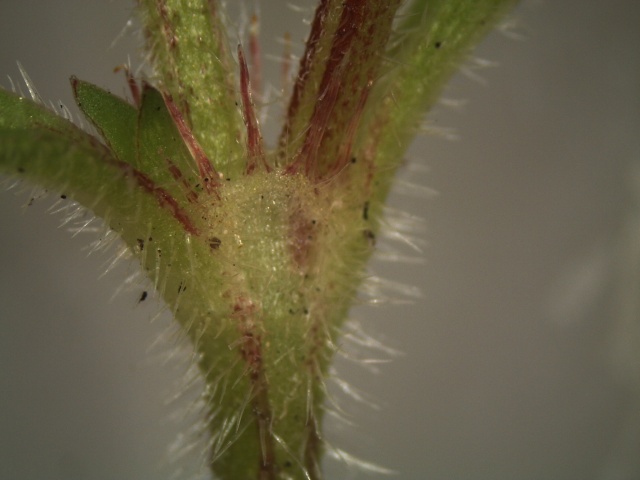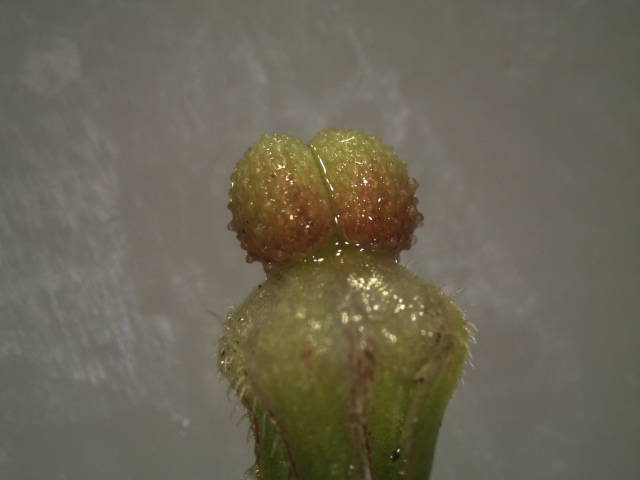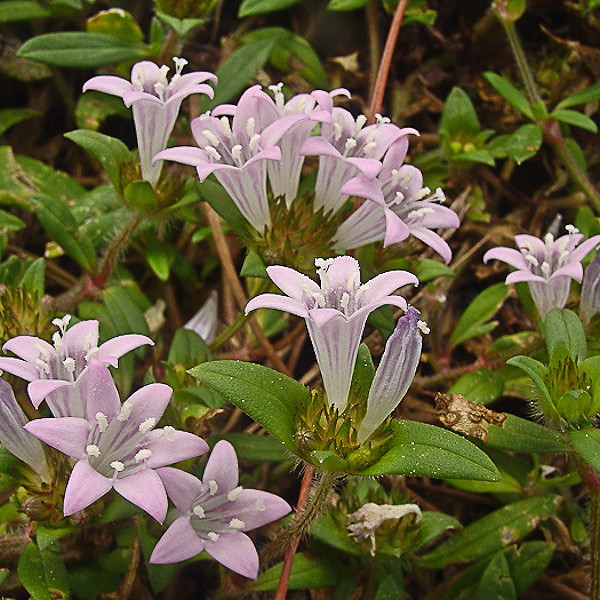Mexican-Clover
Richardia grandiflora
Rubiaceae (Coffee Family)
Returning reluctantly to my office just now from Tropical Smoothie with my Limey Blimey smoothie, heavenly meadows of pink in the athletic field soothed my troubling mind, thanks to a member of my favorite Dicot family, the Coffee Klatsch (aka the Rubiaceae). Typical of life here in Misnomer Meadows, “Mexican-Clover” is no Clover and it is not natively Mexican. Thus for the sake of accuracy some call it Fairy Cups. If you live in South Florida you have seen the pink cloud in the median strip. Some observers say it looks like snow, but those must be Floridians who have never actually seen snow. And just like snow, this weed’s not native to South Florida. South America is home.
The genus Richardia consists of about 15 species ranging naturally from the Southeastern U.S. to Argentina, with some escaped in the Old World. The original native U.S. representation is a messy question beyond the scope today. Some of the species can be tough to distinguish, even in our normal “Treasure Coast-ish” botanical radius. (Handy notes below.)
Any fool can distinguish Richardia grandiflora at 70 mph in the highway median. Seems like cars, lawn mowers, and Global Warming might be expanding its range northward, at least as far as arctic Gainesville, and motivated searchers could probably pinpoint more-northerly patches.
How does one pretty weed take over vast areas of lightly maintained turf as a monoculture? I have no single answer, but here is a bundle of silly notions: 1. The Coffee Family is a talented weed family. 2. The mat sprawls low. I dug one up this morning. The underground rhizome bears roots all over itself, and it sprouts, sprouts, and sprouts near or even below the ground surface. Mowing clearly prompts branching from way down low, allowing this Dicot to pose as a Grass. 3. The weed is mighty drought-tolerant, happy on sterile soils, and probably nematode-proof (just guessing based on a related species). 4. Each fruit splits into a variable number of bumpy little “seeds.” The “seed” production of a single patch is infinite, and all those little crumbs build up a seedbank. 5. And the big question, are Richardias alleleopathic? That is, do they make natural herbicides to suppress competition? I do not know. They look like it, and seem like a study waiting to happen, along with the dormancy characteristics of the fruit segments.
Mexican-Clover has opposite leaves, and between their bases is the hallmark of the Coffee Family, an “interpetiolar” (between the petioles) stipule. The stipule is fringed on top, and basally forms a cup around the node where new buds form. Although often in the Coffee Family the stipule functions to draw symbiotic ants, or to protect the terminal bud, my guess is that in Mexican-Clover the stipule catches water and coddles the sprouting buds nestled like baby kangaroos in the stipular pouch. The stipule is so fancy, I took a picture of one today for reader stipular titillation.

The stipule is fringed on top, and encases the lateral buds (future branches). Rising at 45 degrees on each side are the petioles (leaf stalks).
The fairy cup flowers look like classic butterfly-pollinated blossoms, and butterflies visit, along with bees and other insects. A big patch of MC can be bug-lively. Each flower head is a sponge in a cup, with the maturing fruitlets embedded deep in the moisture. The flowers are packed together tightly with their sepals rising vertically as a collective water trap in the center, reminiscent of some Bromeliad tanks. Bringing a specimen in this morning after a wet night, the flower heads left puddles of water on the microscope stage.
Being a lawn weed, Mexican-Clover raises the boring question, over and over, about “what do you spray on it?” Now please understand, as a pesticideophobic, lunatic fringe nature-nut, this question is not my cup of tea. TC Natives is not for squirt-gun how-to-garden advice. Yet turf herbicides interest me from the dark side. Noodling around Google reveals many recommendations to use Atrazine to get those ugly Fairy Cups out of your lovely yard.

Two bumpy fruit segments. The structure below the twin segments is the semi-persistent calyx (set of sepals).
So now a moment on the Atrazine soapbox. That is bad stuff unless you like deformed amphibians. Atrazine is one of the most-used turf herbicides in the U.S., although alternatives might replace it. Perhaps you thought the U.S. had already pretty much eliminated chlorinated pesticides, such as DDT, Chlordane, and Lindane. Well, is an herbicide a pesticide? I’d like to know, because we still have plenty of chlorinated herbicides, the two main examples being lawn poisons we pay technicians to infuse into our personal environments, 2-4-D, and Atrazine. 2,4-D is a chlorinated (auxin) hormone mimic. And Atrazine has a slight molecular similarity to the fertilizer material urea. Plants take up Atrazine from the soil as they might take up urea. (Where does the rest of the Atrazine go?) Atrazine is so water-soluble it contaminates waters worldwide. And it is implicated ominously in environmental-health issues. Rather than rant, I’ll pass the buck: see what (the controversial) Professor Tyrone Hayes at the University of California has to say on this topic. CLICK
—————————–
Notes:
Distinguishing the species of Richardia in our normal activity radius, especially R. scabra and R. brasiliensis, can be a pain in the grass. By the way, the “handbook” features don’t hold much water. Professor Alexander Krings in North Carolina had the same pain, and did something about it, compiling a guide to this problem. Paraphrasing his work, try this:
Richardia grandiflora is easy: It is the only one with the (usually pink) flowers over 12 mm long.
Richardia brasiliensis: Stems bristly evenly from tip to base, top of leaf evenly hairy, and the inner face (narrowest face) of the fruit segment is broadened (Brazil is a broad country).
Richardia scabra: Stem becoming more or less bare toward base. Top of leaf hairy primarily near the edges. The smallest face of the fruit segment narrowed to a narrow groove.
(The kangaroo pic was stolen from Down Under.)

